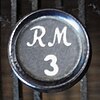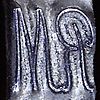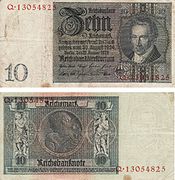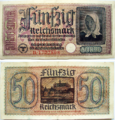Reichsmark
The Reichsmark ( abbreviation RM , currency symbol : ℛℳ) was the legal tender in the German Reich from 1924 to 1948 . This period includes part of the Weimar Republic and the time of National Socialism . After the end of the Second World War in 1945, the Reichsmark was still valid in the occupation zones until the introduction of new currencies in June 1948.
history
The term "Mark" is an old Germanic word and has been used as a weight designation (see Mark ) since the 11th century and derived from it since the 15th century as a designation for coins ( Courantmark , Staatsmark , Marck Danske ).
Introduction of the Reichsmark
The Reichsmark was introduced by the Coin Act of August 30, 1924. The “ paper mark ” had completely lost its purchasing power between 1914 and 1923 ; at first creeping and then in 1923, after the start of the Ruhr occupation and the Ruhr struggle , in a hyperinflation . From November 15, 1923, the German currency was stabilized by the introduction of the Rentenmark .
The exchange rate from the old paper mark to the new Reichsmark was 1,000,000,000,000: 1 (one trillion to one). The Reichsmark was thus equal in value to the Rentenmark in everyday life.
Currency type
A fictitious gold cover of 1/2790 kg fine gold was legally assigned to one Reichsmark . This corresponded to the formal gold cover, as it had existed until the beginning of the First World War in 1914. In contrast to the gold mark , however, the Reichsmark was not a pure gold standard currency and therefore not redeemable at least partially in currency gold coins at the Reichsbank by the citizens. The obligation to redeem Reichsbanknotes in gold was legally stipulated in accordance with Section 31 of the Reichsbank Act - but in practice it never came into force.
The Reichsmark was a so-called gold core currency with no visible gold coin circulation and thus practically a paper currency like today. Formally, however, the previous 10 and 20 mark gold coins from the imperial era were still legal tender until 1938. In practice, however, these did not appear in payment transactions at their face value, since one Reichsmark already had lower purchasing power than the 1914 mark. The so-called “gold core” had essentially only a symbolic meaning in connection with payment settlement transactions with foreign countries.
The silver coins of 1 to 5 RM issued were all divisional coins and had half the silver content of the 1 to 5 marks minted until the beginning of the First World War .
1 Reichs- or Rentenmark ( RM ) = 100 Reichspfennig or Rentenpfennig ( Rpf. )
Expansion of the volume of money in the Third Reich
Since the mid-1930s (" Mefo-Wechsel ") and during the war years from 1939 to 1945, there was a massive increase in the volume of money, primarily to finance German arms production. From the beginning of the Second World War, the population hoarded silver coins of 2 and 5 Reichsmark in large quantities despite the prohibition ( Gresham's law : bad money displaces good money from circulation ). During the Second World War, Reichskreditkassscheine and coins were issued in the countries occupied by the Wehrmacht , which had to be exchanged for national currency by the central banks of the occupied countries - to their disadvantage.
At the end of 1933 the banknotes in circulation amounted to 4.2 billion RM; in July 1939 it was 9.0 billion RM. At the end of 1939 it was 11.8 billion RM; At the beginning of 1945, RM 73 billion.
To replace coins with paper money, new Rentenmark notes were put into circulation within the Reich shortly before the start of the war .
Devaluation and abolition of the Reichsmark after the Second World War
As a result of the expansion of the volume of money and due to the enormous damage caused by the war, which drastically reduced the material assets in relation to the volume of money, the Reichsmark had little purchasing power after the war. The fact that many areas of goods were subject to the management with vouchers and that the prices were also fixed, also reduced the importance of the Reichsmark as a currency, there was no free convertibility anyway.
In the years 1945 to 1948, small coins of 1, 5 and 10 pfennigs were reissued, which bore an eagle without a swastika, but otherwise continued to bear the designations Reichspfennig and German Reich .
With the currency reforms of June 21, 1948 ( West ) and June 23 / July 24, 1948 ( East ), the Reichsmark became invalid at the same time as the last Rentenmark banknotes and the German Mark (DM) in the three western zones of Germany , in the Soviet zone the Deutsche Mark of the German Central Bank (then MDN = Mark of the German Central Bank and finally M = Mark of the GDR ). Old credit balances at West Berlin credit institutions were not converted to DM until 1953.
In the law on the completion of the currency conversion it was regulated that with the expiry of June 30, 1976 the claims from Reichsmark credits expired.
Reichsmark in Austria
In the area of National Socialist Austria after the “ Anschluss ” in 1938, the Reichsmark had been declared legal tender through a currency reform and had replaced the Austrian Schilling at a ratio of 1.5: 1. Here on November 30, 1945 the schilling was reintroduced at an exchange ratio of 1: 1 and the Reichsmark was declared invalid. However, the coins and the Rentenbank notes of the Reichsmark currency were used for a transitional period.
The " Allied Military Schilling ", introduced in 1945 parallel to the Reichsmark, was not partially taken out of circulation in Austria until the end of 1947.
Purchasing power
The purchasing power equivalents of one Reichsmark are given by the Deutsche Bundesbank in relation to the purchasing power of the euro as of August 2019 as follows:
- 1 Reichsmark 1924 = € 3.90
- 1 Reichsmark 1937 = € 4.10
See also
- Register mark
- Average earnings (historical values of average earnings during the Reichsmark)
Coins
- Circulation coins of the Weimar Republic
1 Rpf, 1924 ( copper )
4 Rpf, 1932 (copper), " Brüning-Taler "
5 Rpf, 1936 (copper- aluminum alloy)
Commemorative coins 1925–1934
From 1925, coins with denominations of 3 and 5 RM were minted in 500 silver (a silver alloy with a fineness of 500 parts). The first issue was dedicated to the Rhineland Millennium in 1925 (3 and 5 RM); the last commemorative coins in the Weimar Republic were issued in 1932 on the 100th anniversary of the death of Johann Wolfgang von Goethe , again with 3 and 5 RM coins. At the time of National Socialism there were three more commemorative missions - 2 (625 silver) and 5 RM (900 silver) - in 1933 ( Martin Luther's 450th birthday ) and 1934 (first anniversary of Potsdam Day on March 21, 1934; 175th birthday of Friedrich Schiller ). This ended the series of commemorative issues in Reichsmark currency.
- Two Reichsmark commemorative coins from the time of National Socialism
Martin Luther
1483–1933Day of Potsdam
March 21, 1933Friedrich Schiller
1759–1934
- Five Reichsmark commemorative coins from the time of National Socialism
- Cross-reference: Three and five Reichsmark commemorative coins from the Weimar Republic → List of Reichsmark coins from the Weimar Republic
Banknotes
Imperial banknotes of the Weimar Republic
- 1924
- 1929
10 RM
VS : Head portrait of
Albrecht Daniel Thaer
RS : Allegory of Agriculture20 RM
VS: Head portrait of
Werner von Siemens
RS: Allegory of handicraft
| Banknote RM | Date printed | In circulation from | In circulation until |
|---|---|---|---|
| 10 | October 11, 1924 | October 1924 | January 30, 1934 * |
| 20th | October 11, 1924 | October 1924 | January 30, 1934 * |
| 50 | October 11, 1924 | October 1924 | June 20, 1948 |
| 100 | October 11, 1924 | October 1924 | June 20, 1948 |
| 1000 | October 11, 1924 | October 1924 | June 20, 1948 |
| 10 | January 22, 1929 | February 1931 | June 20, 1948 |
| 20th | January 22, 1929 | December 1930 | June 20, 1948 |
* Denomination January 31, 1934
Reichsbanknotes of the Nazi state
5 RM
VS: Young man's head
RS: Brunswick Cathedral with lion monument
allegory of agriculture and handicraft50 RM
VS: Head portrait of
David Hansemann
RS: Allegory of trade100 RM
VS: Head portrait of
Justus von Liebig
RS: Allegory of Science1000 RM
VS: Head portrait of
Karl Friedrich Schinkel
RS: Allegory of architecture
| Banknote RM | Date printed | In circulation from | In circulation until |
|---|---|---|---|
| 5 | August 1, 1942 | June 1943 | June 20, 1948 |
| 20th | June 16, 1939 | February 1945 | June 20, 1948 |
| 50 | March 30, 1933 | Spring 1934 | June 20, 1948 |
| 100 | June 24, 1935 | Mid-1936 | June 20, 1948 |
| 1000 | February 22, 1936 | September 1944 | June 20, 1948 |
The 20 Reichsmark note was originally made as a 100 Schilling note for Austria , but was no longer issued due to its affiliation with the German Reich.
literature
- C. Schaeffer, H. Brode: General Economics. Verlag CL Hirschfeld, Leipzig 1927.
Web links
Individual evidence
- ↑ Coin Law in the RGBl. II 1924, p. 254
- ^ Reichsbank Act of August 30, 1924, in RGBl. II, 1924, No. 32, pp. 235-246
- ↑ Niels Werber in a review of Götz Aly's book Hitler's People's State , In: Frankfurter Rundschau , March 22, 2005
- ↑ Manfred Borchert: Money and Credit: Introduction to Monetary Theory and Monetary Policy , page 13
- ↑ StGBl. No. 231/1945 : §§ 2 Paragraph 2 lit. c) and d), 3 para. 2 Act of November 30, 1945 on measures in the field of currency (Schilling Act)
- ↑ Allied military schilling notes, series 1944
- ↑ Purchasing power comparisons of historical amounts of money. Deutsche Bundesbank, accessed on January 10, 2020 .
- ↑ Purchasing power equivalents of historical amounts in German currencies. (PDF) August 2019, accessed on January 17, 2020 (the figures in the article are taken from this extensive year-based table as an example).
- ↑ Helmut Caspar: From Taler to Euro. The Berliners, their money and their coins. 2nd, corrected edition. Berlin Story, Berlin 2006, ISBN 978-3-929829-30-3 , pp. 166 and 231.
- ↑ a b c Paper money in the German Empire 1871–1948 Deutsche Bundesbank (PDF file)




















































